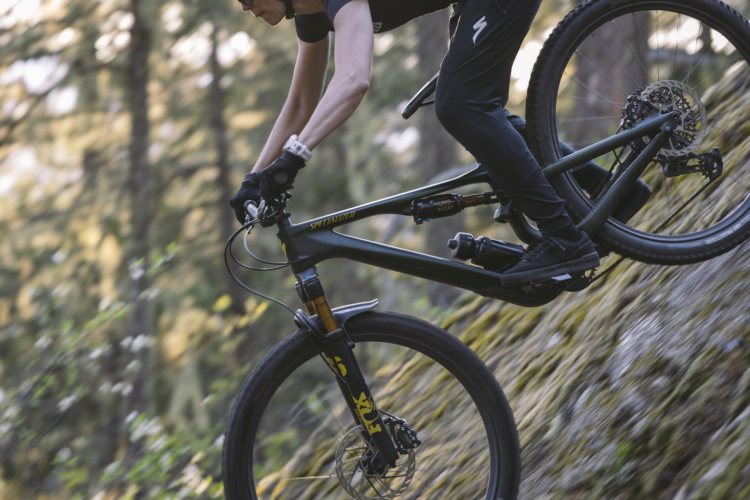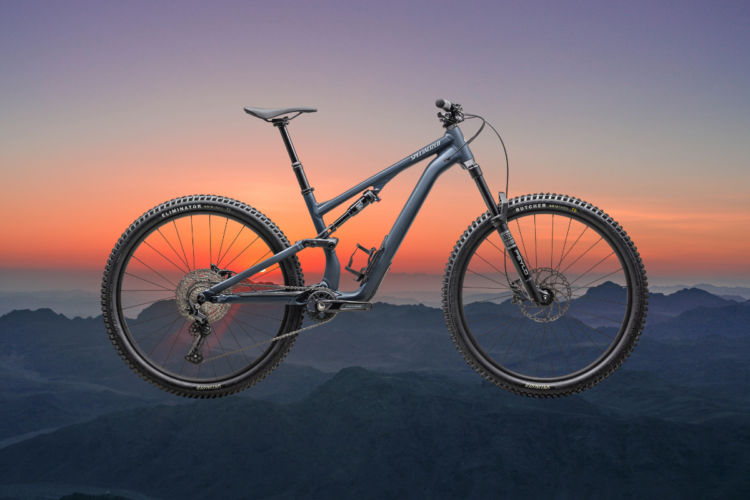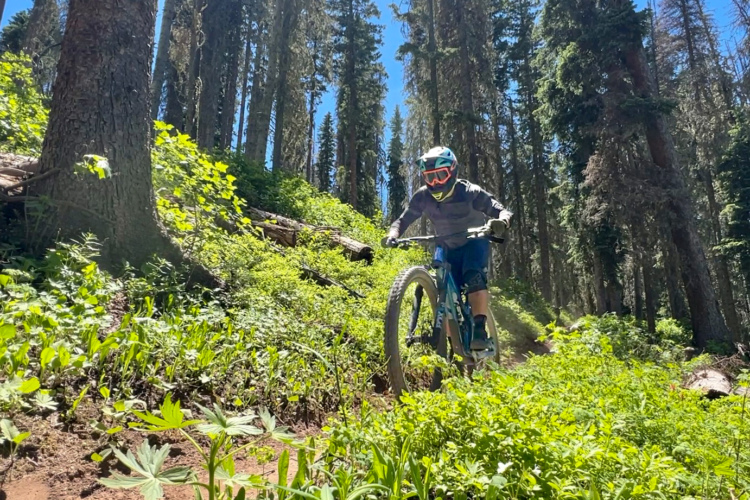
I have a lot of respect for Specialized, but I’m no fanboy. I’ve never owned one of their bikes, and though I’ve tested a number of Specialized mountain bikes over the years — including three previous generation Stumpjumpers — none of the bikes particularly stood out to me. That is, until I tested the Specialized Stumpjumper 15 over the summer and fall. It’s easily the most refined mountain bike I’ve ridden, thanks to its GENIE suspension tech, smart frame design, thoughtful geometry, and solid build selection.

GENIE suspension tech delivers the goods.
From my first ride on the Specialized Stumpjumper 15, I was impressed with the suspension performance. The Stumpjumper 15 Comp build features a Fox 36 Performance fork which is a nice fork, but certainly not top of the line. The real star of the show is the all-new and exclusive FOX FLOAT Performance shock with Specialized GENIE Shock Tech that promises a combination of “the control enhancing linear spring rate of a coil spring through the ‘bump zone’ with the progressive spring rate of an air spring at the end of the stroke.”
GENIE shocks accomplish this with dual positive air chambers and a large overall volume. The upshot is a lower spring rate early in the stroke and a higher rate at the end of the stroke. I won’t geek out on all the tech involved, and I won’t bother repeating the full list of marketing claims, but if you’re interested, you can read through the white paper below. What I will tell you is how it performs on the trail.
Descending traction and control are superb.
Perhaps the biggest and most notable benefit of GENIE shock technology, at least to this trail rider, is incredible descending traction and control. I immediately noticed the rear wheel spends far more time connected with the ground than other bikes I’ve ridden. According to their own tests, Specialized found the GENIE shock loses traction 57% less than a standard air shock. Through rough rocks and roots, the Stumpjumper 15 tracks confidently and sticks to its line, perhaps better than any bike I’ve ridden.
At low to medium speeds, GENIE gives the bike a supple, comfortable feel that seems just right for a trail bike. At higher speeds and with bigger hits, the bike takes on a new character that’s more business-like. Though I wouldn’t describe the Stumpjumper 15 as a particularly playful or poppy bike, it’s easy enough to get into the air. However, on landing, it’s clear the bike has plenty to give with a super composed bottom-out and exponential ramp.
Share your Specialized Stumpjumper 15 review
A trail bike should be designed to handle pretty much any trail type imaginable, and the Stumpjumper 15 is perhaps the poster bike for doing it all. But if I had to give the bike an edge between tech and flow trails, I might give it a slight edge for the rougher stuff based on how well the suspension handles abrupt transitions and how quickly it recovers and sets up for the next object in its path. This isn’t surprising given that the newest Stumpjumper adds a significant 15mm of rear suspension travel over the previous version plus 10mm more up front, bringing it close to what was heretofore Stumpjumper EVO territory.
Still, it’s hard to think of a more confident bike on fast, flowy trails. In this area, I think as much, if not more, credit is due to the build choices, which I’ll talk about later in this review.
I didn’t do much to hide my skepticism about many of the fantastic claims that were made when the Stumpjumper 15 was announced earlier this year. I still don’t fully understand GENIE suspension tech, but having ridden it, I can say it’s a game-changer, at least for me.
Solid climbing platform
Even more so than an enduro bike, a trail bike like the Specialized Stumpjumper 15 needs to climb comfortably and efficiently. With a coil-like initial stroke, GENIE allows the bike to hug the ground for maximum climbing traction over technical terrain. With the two-position switch in the climbing position, the Stumpjumper delivers a very stable climbing platform with minimal pedal bob. For rolling terrain rides, I found pedaling with the shock in the open position was fine, but for longer sustained climbs, it definitely pays to switch into climb mode.
Climbing or descending, the Specialized Stumpjumper 15 is incredibly quiet. The only sounds you’ll hear are the mechanical squeaks when changing gears and the compression of the dropper post at the start of the descent.



15 generations of chassis refinement
One of the most striking visual changes to the Specialized Stumpjumper 15 is the lack of a brace between the top tube and seat tube as seen in previous generations. This gives the bike a cleaner, albeit less distinctive look overall.
The SWAT 4.0 in-frame downtube storage has been optimized, with an easy-to-use, rattle-free latch system that holds tight and secure. Inside, there’s room for a full-size 29er tube plus a pump and other tools. Specialized has maximized the space available, more so than other brands I’ve tested, which makes it easy to add and remove emergency supplies when you need them.
Specialized Stumpjumper 15 carbon frames go all-in on wireless electronic shifting, with internal routing for the rear brake hose and dropper post only. Ports on the left and right side of the headtube are placed to give the hose and cable a more gradual transition into the frame. Running a set of SRAM Maven brakes with Stealth lever design, riders get a very clean and manageable cockpit.

The Stumpjumper 15 comes with durable frame protection in all the right places, with an excellent fit. The ribbed, chain-slap-quieting chainstay protection, which Specialized pioneered back in 2018, is largely unchanged and is just as effective as ever. In addition, there’s generous protection running from beneath the bottom bracket and up the downtube, and a tiny fender flap that protects the linkage from dirt and debris.

The Specialized Stumpjumper geometry and fit are dialed.
I’m 6’3″ tall and tested a size S5 Stumpy. Specialized has an online tool to help riders find the right size, and after entering my data the tool recommended the largest S6 size. Even so, the S5 fits me better out of the box than any of the mountain bikes I own. The 500mm reach isn’t overly aggressive, but I think what really makes the difference for me is the 654mm stack height. If you’ve read my bike reviews over the past few years, I’ve complained about low stack heights, most of which are at least 20mm lower than the size S5 Stumpjumper I tested.
It’s clear the S5 provides a proper fit for tall riders, and the larger S6 promises to fit even taller folks. I do wonder how the S1 and S2 sizes fit smaller riders, so if you have experience riding one of these sizes of the Stumpjumper 15, please let me know how it fits in the comments below.
The upshot of the higher stack height and right-sized reach, at least for me, is a bike that’s more comfortable on the climbs. I’m not hunched over the bike, and when it’s time to descend steep slopes, my weight gets closer to being over the bottom bracket rather than the front axle.
| S1 | S2 | S3 | S4 | S5 | S6 | |
|---|---|---|---|---|---|---|
| Crank Length | 165mm | 165mm | 165mm | 170mm | 170mm | 170mm |
| Handlebar Width | 780mm | 780mm | 800mm | 800mm | 800mm | 800mm |
| Stem Length | 40mm | 40mm | 40mm | 40mm | 40mm | 40mm |
| Saddle Width | 155mm | 155mm | 143mm | 143mm | 143mm | 143mm |
| Seatpost Length | 125mm | 150mm | 170mm | 190mm | 190mm | 190mm |
| Stack | 608mm | 618mm | 627mm | 640mm | 654mm | 667mm |
| Reach | 400mm | 425mm | 450mm | 475mm | 500mm | 530mm |
| Headtube Length | 95mm | 100mm | 110mm | 125mm | 140mm | 155mm |
| Headtube Angle | 64.5° | 64.5° | 64.5° | 64.5° | 64.5° | 64.5° |
| BB Height | 334mm | 337mm | 337mm | 337mm | 337mm | 337mm |
| BB Drop | 41mm | 38mm | 38mm | 38mm | 38mm | 38mm |
| Trail | 129mm | 130mm | 130mm | 130mm | 130mm | 130mm |
| Fork Length (full) | 551mm | 561mm | 561mm | 561mm | 561mm | 561mm |
| Fork Rake/Offset | 44mm | 44mm | 44mm | 44mm | 44mm | 44mm |
| Front Center | 720mm | 751mm | 780mm | 812mm | 843mm | 879mm |
| Chainstay Length | 430mm | 432mm | 435mm | 435mm | 445mm | 445mm |
| Wheelbase | 1149mm | 1181mm | 1213mm | 1244mm | 1285mm | 1322mm |
| Top-tube Length (horizontal) | 541mm | 573mm | 595mm | 624mm | 647mm | 677mm |
| Bike Standover Height | 738mm | 751mm | 745mm | 745mm | 745mm | 751mm |
| Seat Tube Length | 385mm | 385mm | 405mm | 425mm | 445mm | 465mm |
| Seat Tube Angle | 78° | 77° | 77° | 76.5° | 76.5° | 76.5° |
| Saddle Height for Effective ST Angle | 645mm | 690mm | 735mm | 780mm | 825mm | 870mm |
| Max Seatpost Insertion | 245mm | 245mm | 255mm | 255mm | 285mm | 285mm |
| Min Seatpost Insertion | 80mm | 80mm | 80mm | 80mm | 80mm | 80mm |


The 64.5° head tube angle is balanced by a 76.5° seat tube angle on the size S5 bike. This keeps the front wheel firmly planted on the climbs, though at times it feels like I’m pushing forward on the pedals more than I should. Smaller frame sizes sport steeper seat tube angles, and I think the larger sizes could benefit from a slightly steeper angle as well. (Though to be fair, this would likely throw another dimension out of whack.) Setting the adjustable angle headset on the Stumpjumper 15 to the “slack” position drops the head tube angle to 63.5° and makes the seat tube ever-so-slightly steeper, so that is an option at least.
Specialized varies chainstay lengths from 430mm on the smaller sizes to 445mm on the larger sizes, including the S5 I tested. I suspect this longer-than-average chainstay length contributes to the comparatively less playful ride feel I experienced on the trail.




The Stumpjumper 15 Comp build delivers where it matters.
The Stumpjumper 15 Comp I tested is the most affordable carbon build Specialized offers. Because the frame isn’t compatible with a mechanical drivetrain, the bike starts with the least expensive SRAM wireless drivetrain, S1000 Eagle Transmission. I found the S1000 drivetrain performs just as well as the other Transmission drivetrains, which is to say it’s great. And the Fox 36 Rhythm fork is stiff enough and has no problem keeping up with the magical GENIE shock in the rear.
SRAM Maven Bronze brakes are a standout choice for this build, not just because they keep the cockpit looking nice and neat, but because they’re so dang powerful. Greg says the top-of-the-line Maven Ultimate brakes are “the new standard by which all MTB brakes will be measured,” and while I haven’t tested the Ultimates, the Bronze Mavens are about as powerful as I think I’ll ever need. When it comes to SRAM brakes, I haven’t been a fan in the past, but it’s undeniable the Mavens are great. They’re powerful, yes, but also deliver the right amount of modulation to use judiciously in a variety of conditions.
And yet, I didn’t need to use the SRAM Maven Bronze brakes all that often thanks to the Specialized Butcher Grid Trail T9 tire up front. I’ve tested most of the Specialized mountain bike tire line on various other bikes over the past couple of seasons, but never the Butcher. It’s now tied for my favorite front tire with the venerable Maxxis Minion DHF. The Butcher offers incredible cornering control and traction that’s predictable and easy to use. It’s a heavy, knobby tire that surely slows me down on the flats and the climbs, but it’s worth every extra calorie burned, and then some.
The one area where I think Specialized skimped and where buyers may want to consider an upgrade is the wheelset. I found the wheelset, with alloy Specialized rims, to be twangy and at times jangly, particularly the rear wheel through technical and square-edge sections. I’m generally pretty light on mountain bike wheels, and even I found the stock rear wheel to be flat-prone and full of complaints. More than once, I pulled off to the side of the trail mid-descent to make sure the rear wheel and tire were getting along.
The Stumpjumper Expert build upgrades to Roval Traverse alloy rims which hopefully deliver more robust performance. I do think the stock Specialized rims would be fine on most bikes, but the rest of the Stumpjumper Comp is so capable that the wheels become a limiting factor. For those with a much higher budget, the $9,000 Pro build comes with Roval Traverse SL II wheels which I’ve tested and have found to be very capable indeed.
I was pleasantly surprised by how well the X-Fusion Manic dropper post, with 190mm of travel, performs. With a 34.9mm diameter, the Manic feels solid, and though it takes a bit of force to get the seat to drop, there’s a satisfying whoosh sound that lets you know it’s pressurized and ready to pop back up at a moment’s notice.
Specialized Stumpjumper 15 key specs
- Suspension travel: 150/145mm front/rear (140/145mm size S1)
- Weight: 14.97kg as tested (about 33lb)
- Price: $3,000 to $13,500 ($5,500 as tested)
- Buy from Specialized

Pros and cons of Specialized Stumpjumper 15
Pros
- Incredible suspension performance thanks to GENIE shock tech
- Excellent fit and geometry
- Build kit is on point and delivers excellent value
- Refined frame design and features
Cons
- Stock wheels on the Comp build are under-gunned for the Stumpy’s capabilities
Bottom line
I’ve easily tested more than 100 mountain bikes over the years, but none have been as capable and refined as the Specialized Stumpjumper 15. I’m sure bikes will continue to get even better, but after testing this one, it’s hard to imagine how they’ll improve on this design.





















16 Comments
Dec 3, 2024
I always love to see companies innovating!
Dec 4, 2024
I will need to test one of these at some point, but until they add cable ports to the carbon frame it’s a total non-starter.
Dec 5, 2024
Dec 3, 2024
Dec 3, 2024
Dec 3, 2024
Dec 4, 2024
Dec 3, 2024
Dec 7, 2024
18 hours ago
Dec 4, 2024
Dec 3, 2024
Dec 3, 2024
Dec 3, 2024
I'm fortunate to have the S4 S-Works which fits me like a glove so I can relate to your comment about your fitment. They absolutely nailed it with this design!
Dec 4, 2024
Dec 8, 2024
2023 ripmo
2016 stumpjumper elite
2009 stumpjumper elite
Rear triangle of both stumpys broke (while climbing) after 7 yrs of riding.
I rode the 2023 ripmo and the 2023 stumpy evo back to back. It was tight. I picked the ripmo - super liking it.